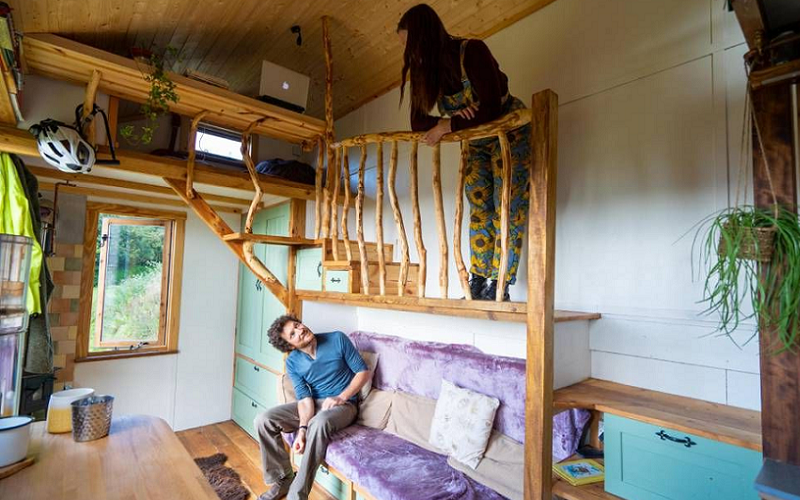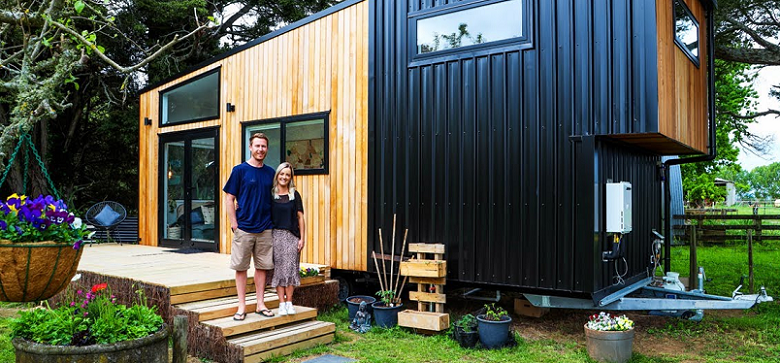
Tiny houses have been gaining popularity as a housing alternative in recent years, and for good reason. These small, mobile homes offer many benefits, from increased financial freedom to a more eco-friendly lifestyle. However, living in a tiny house also comes with its own set of challenges. Here we explore the benefits and challenges of living in a tiny house and provide tips for making tiny house living work for you. Whether you’re considering downsizing or just curious about this unique way of living, read on to learn more.
What Is a Tiny House?
A tiny house is a small, fully functional living space that is designed to maximize efficiency and minimize excess space. The concept of tiny houses is based on the idea of simplifying living spaces and embracing a minimalist lifestyle. These homes range in size from as small as 80 square feet to as large as 400 square feet, although the most common size is around 200 square feet.
One of the defining features of tiny houses is their compact and efficient design. Every square inch of a tiny house is carefully considered to serve a specific purpose. These homes typically include a kitchen, bathroom, living area, and sleeping area, but the layout and design can vary depending on the needs and preferences of the homeowner.
Tiny houses can be built on a foundation or on a trailer, making them mobile and allowing homeowners to move their home to different locations. This mobility is one of the most appealing aspects of tiny houses, as it offers the freedom to travel or relocate without the cost and hassle of traditional home ownership.
The construction of a tiny house often incorporates eco-friendly materials and energy-efficient systems, such as solar panels, composting toilets, and rainwater collection systems. The use of these sustainable technologies not only reduces the environmental impact of tiny house living but also helps to lower utility bills and maintenance costs.
Despite their small size, tiny houses can be surprisingly comfortable and stylish. Many homeowners incorporate creative design features and functional storage solutions to make the most of their limited space. Some tiny houses even have features like skylights, balconies, and lofts to provide a sense of openness and spaciousness.

Benefits of Living in a Tiny House
Living in a tiny house offers a range of benefits, both practical and lifestyle-related. Here are some of the most significant benefits of living in a tiny house.
Reduced Living Costs of a Tiny House
Living in a tiny house can greatly reduce the cost of living. Tiny houses are generally much cheaper to build, buy, and maintain than traditional houses. They require fewer materials and less labor to build, and the smaller size means lower utility bills and reduced maintenance costs. In addition, the lower cost of living can free up more time and money to pursue other passions, such as travel or starting a business.
Tiny Homes Offer More Sustainable Living
Living in a tiny house is a more sustainable way of living. Tiny houses are often constructed using eco-friendly materials and incorporate sustainable technologies such as solar panels, composting toilets, and rainwater collection systems. The smaller size of tiny houses means less energy is needed to heat or cool the space, reducing the overall carbon footprint of the home. The sustainable lifestyle can lead to a sense of satisfaction and purpose that comes with taking care of the planet.
Tiny Homes Provide for a Simpler Lifestyle
Tiny houses require a more minimalistic lifestyle, which can be a huge advantage for many people. Having less space means fewer possessions, which can lead to a simpler, less stressful life. In addition, tiny houses are typically located in more rural areas, which allows homeowners to disconnect from the hustle and bustle of urban life and spend more time in nature. A simpler lifestyle can lead to increased mental clarity and a greater sense of well-being.
Flexibility and Mobility of a Tiny House
The mobility of a tiny house is a significant benefit for those who love to travel or want the freedom to live in different locations. Tiny houses are often built on a trailer, making them easy to move from one location to another. This allows homeowners to live closer to nature or to travel while still having a comfortable home. In addition, tiny houses can be placed on almost any piece of land, making it easier to live in rural areas and enjoy a simpler lifestyle.
Cozier Living Space of a Tiny House
Despite their small size, tiny houses can feel cozy and welcoming. With careful design and planning, the space can be personalized to fit the needs and preferences of the homeowner. Cozy living spaces foster closer relationships with family and friends, and the intimate space encourages homeowners to spend more time outdoors and engage in activities with others.
Tiny Homes Mean a Lower Environmental Impact
Tiny houses have a smaller environmental footprint than traditional houses. They require less energy to heat or cool, which means less energy is needed overall. The sustainable technologies used in many tiny houses, such as solar panels and composting toilets, also reduce the environmental impact. Living in a tiny house can be a step towards a more environmentally friendly lifestyle, and it can make a real difference in reducing the overall carbon footprint of the homeowner.

Challenges of Living in a Tiny House
Living in a tiny house presents unique challenges that come with its many benefits. The biggest challenge of living in a tiny house is the limited living space. These houses are typically 200 square feet or less, which can make it difficult to accommodate more than one or two people. Limited space also means less room for storage and fewer places to store personal belongings.
Another challenge of tiny house living is the lack of privacy. With fewer rooms and walls, sounds and activities can be heard and seen throughout the entire space. This can be especially difficult if more than one person is living in the tiny house, and privacy may be hard to find.
Finding a suitable location to park a tiny house can also be a challenge. Many municipalities have zoning laws that make it difficult or impossible to park a tiny house on residential land. Finding a location to park a tiny house can be a major obstacle for those who want to live in a tiny house.
Building codes and zoning regulations can also be challenging to navigate for tiny house owners. Since tiny houses are a relatively new housing option, many areas do not have specific codes or regulations that apply to them. This can make it difficult to obtain permits or approvals to build or park a tiny house.
Finally, tiny houses often have limited storage space and amenities compared to traditional homes. For example, tiny houses may not have running water or a full bathroom. Cooking and cleaning can also be challenging in a small kitchen, and there may not be room for large appliances.

Tips for Successful Tiny House Living
Living in a tiny house can be a fulfilling and rewarding lifestyle, but it also requires some adjustments and planning. Here are some tips for successful tiny house living.
- Plan ahead: Before building or buying a tiny house, it’s important to plan ahead and create a layout that maximizes space and functionality. Careful planning can help to ensure that the space is used efficiently and effectively.
- Create designated storage areas: Since storage space is limited in a tiny house, it’s important to create designated storage areas and organize possessions effectively. This can include adding shelves, storage containers, and other organizational tools to make the most of the available space.
- Utilize outdoor spaces: To make the tiny house feel larger, it’s important to utilize outdoor spaces and incorporate greenery. This can include adding a deck or patio to create additional living space or incorporating plants and other outdoor features to create a sense of openness.
- Be intentional about possessions: In a tiny house, it’s important to be intentional about what possessions to keep and what to get rid of. Every item needs to serve a specific purpose, and it’s important to avoid clutter and excess belongings.
- Build a strong support system: Living in a tiny house can be challenging, so it’s important to build a strong support system of like-minded individuals. This can include joining tiny house communities, attending events, or connecting with other tiny house owners online.
- Be prepared for challenges: Tiny house living comes with its own set of challenges, such as limited living space and zoning regulations. It’s important to be prepared for these challenges and have a plan in place to overcome them.
